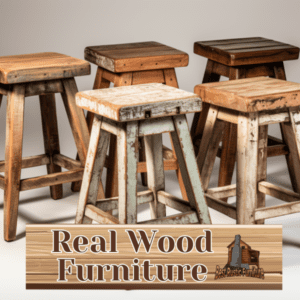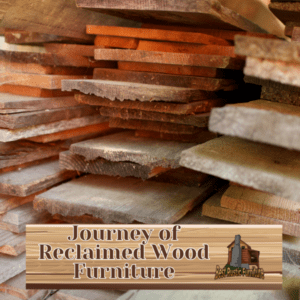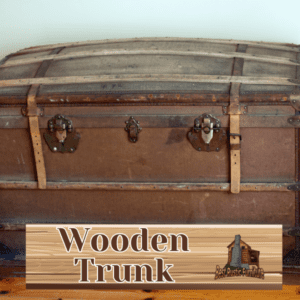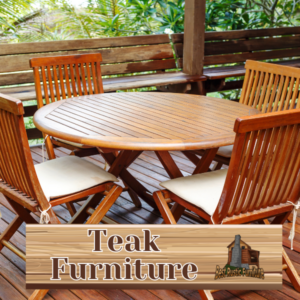
Rustic furniture, known for its charm and timeless appeal, has continuously evolved with the changing times. From traditional designs to contemporary adaptations, rustic furniture has witnessed significant transformations in its aesthetics and functionality. This article explores the evolution of rustic furniture, its influence from modern times, key features of modern rustic furniture, the popularity it holds, and the future trends it is expected to embrace.
The evolution of rustic furniture can be traced through different eras. Traditional rustic furniture embodied the essence of simplicity and craftsmanship, showcasing natural materials and handcrafted details. In the mid-20th century, rustic furniture underwent a shift towards more streamlined and minimalist designs, influenced by modernist principles. Contemporary rustic furniture blends traditional elements with modern sensibilities, incorporating sleek lines and innovative materials.
Modern times have greatly influenced rustic furniture, bringing about notable changes in design and construction. One key influence is the incorporation of modern materials such as reclaimed wood, metal accents, and sustainable fabrics. Rustic furniture has also embraced fusion, blending rustic and modern design elements to create unique and eclectic pieces. Rustic furniture has adapted to changing lifestyles, offering functional and versatile solutions for modern homes.
Key features of modern rustic furniture include simplicity and functionality. Modern rustic pieces prioritize practicality while retaining the rustic charm. They also emphasize eco-friendly and sustainable practices, making use of reclaimed materials and environmentally conscious manufacturing processes. The aesthetics of modern rustic furniture lean towards an organic and natural appeal, celebrating the beauty of imperfections and the rawness of natural materials.
Modern rustic furniture has gained significant popularity due to its broad appeal. It caters to various design preferences, ranging from those who appreciate rustic and traditional aesthetics to those who seek a more contemporary and eclectic style. Modern rustic furniture also fosters a connection to nature and the outdoors, bringing a sense of calm and tranquility to interior spaces. The nostalgia and vintage charm associated with rustic furniture resonate with individuals seeking a warm and inviting ambiance.
Looking towards the future, rustic furniture in modern times is expected to integrate technology seamlessly. Smart features and innovative materials will be incorporated into rustic designs to enhance functionality and convenience. Customization and personalization will play a crucial role, allowing individuals to tailor rustic furniture to their specific needs and preferences. Furthermore, the future of rustic furniture will prioritize sustainable practices, with an emphasis on responsible sourcing, eco-friendly manufacturing, and recyclable materials.
As rustic furniture continues to evolve, it maintains its timeless appeal while embracing the demands and trends of modern times. With its blend of rustic charm, simplicity, and adaptability, modern rustic furniture is set to enrich interior spaces for years to come.
Key takeaways:
- Rustic furniture adapts to modern materials: Contemporary rustic furniture incorporates modern materials such as metal and glass to create unique pieces that blend traditional and modern elements.
- Rustic furniture embraces sustainability: With a focus on eco-friendly practices, modern rustic furniture utilizes reclaimed wood and natural finishes, appealing to environmentally conscious consumers.
- Rustic furniture appeals to diverse design preferences: The popularity of modern rustic furniture stems from its ability to cater to various design preferences, offering simplicity, functionality, and a connection to nature.
The Evolution of Rustic Furniture
As rustic furniture seamlessly adapts to the demands of modern times, its evolution continues to captivate both traditionalists and contemporaries alike. Prepare to journey through the captivating sub-sections that shed light on traditional rustic furniture, the mid-20th century renaissance, and the awe-inspiring world of contemporary rustic furniture. Buckle up and discover how this timeless art form has seamlessly transitioned through ages, embracing new designs, techniques, and materials, while retaining its rustic charm.
Traditional Rustic Furniture
Traditional rustic furniture has a timeless appeal and is characterized by its natural materials, simple designs, and handcrafted quality. Made from solid wood: Traditional rustic furniture is typically crafted from solid wood, such as oak, pine, or maple, which adds to its durability and rustic charm. Simplicity in design: Traditional rustic furniture features clean lines and minimal ornamentation, focusing on functionality rather than elaborate details. Natural finishes: The wood used in traditional rustic furniture is often left in its natural state or finished with simple techniques like staining or oiling to enhance its natural beauty. Handcrafted techniques: Traditional rustic furniture is often handmade by skilled artisans, utilizing traditional joinery methods and techniques to ensure quality craftsmanship. Warm and inviting: The natural materials and earthy tones of traditional rustic furniture create a warm and welcoming atmosphere in any space.
Rustic Furniture in the Mid-20th Century
- Rustic Furniture in the Mid-20th Century experienced significant changes in its design and popularity.
- Influence of Modern Design: Rustic furniture began incorporating modern design elements, such as clean lines and minimalist shapes.
- Introduction of new materials: During this era, rustic furniture started to use materials like metal and plastic, adding a contemporary touch.
- Changing Lifestyles: Rustic furniture had to adapt to fit smaller spaces and match the aesthetics of modern homes as urban and modern lifestyles became more prevalent.
- Influence of the Mid-Century Modern Movement: The mid-century modern movement played a role in shaping rustic furniture by emphasizing functionality and simplicity.
- Greater Accessibility: Thanks to mass production and increased affordability, rustic furniture became accessible to a wider audience during the mid-20th century.
Contemporary Rustic Furniture
Contemporary rustic furniture combines the charm of traditional rustic design with modern elements, creating a unique and stylish aesthetic. Here are some key features of contemporary rustic furniture:
- Blend of materials: Contemporary rustic furniture often incorporates a mix of materials such as wood, metal, and glass, creating a visually interesting contrast.
- Sleek and streamlined design: While rustic furniture traditionally had a more rustic and rough appearance, contemporary rustic furniture has cleaner lines and a more minimalist design.
- Use of natural finishes: Contemporary rustic furniture often showcases the natural beauty of wood through clear or light finishes, giving it a modern touch.
- Functional and practical: Contemporary rustic furniture combines style with functionality, offering pieces that are not only visually appealing but also serve a purpose.
- Integration of modern technologies: Contemporary rustic furniture may incorporate modern technologies like built-in charging stations or adjustable features for added convenience.
When choosing contemporary rustic furniture, consider your personal style, the overall aesthetic of your space, and the specific functionality and features you need. Look for pieces that seamlessly blend rustic and modern elements, adding warmth and character to your home.
Contemporary Rustic Furniture
The Influence of Modern Times on Rustic Furniture
Rustic furniture has stood the test of time, embodying timeless charm and natural beauty. But how has it evolved? In this section, we’ll dive into the influence of modern times on rustic furniture, exploring three key aspects: the incorporation of modern materials, the fusion of rustic and modern design elements, and its adaptation to changing lifestyles. Get ready to discover how rustic furniture gracefully embraces the present while staying true to its rustic roots.
Incorporation of Modern Materials
| Traditionally, rustic furniture was made using natural materials such as wood, stone, and metal. |
| In recent years, there has been a natural blend of modern and traditional materials to create a unique twist on rustic furniture. |
| Materials such as glass, acrylic, and even concrete are now being used alongside traditional elements. |
| This combination of modern and rustic materials creates a beautiful contrast and adds a contemporary touch to rustic furniture designs. |
| For example, a rustic wooden dining table with a glass or acrylic top creates an interesting incorporation of modern materials while retaining the old charm. |
Pro-tip: When incorporating modern materials into rustic furniture, consider the overall aesthetic and functionality it will bring to the piece. Choose materials that complement the existing design elements and add a modern touch without overpowering the rustic charm.
Fusion of Rustic and Modern Design Elements
“`
The fusion of rustic and modern design elements in furniture has become increasingly popular in recent years, resulting in unique and captivating pieces that combine the charm of the past with the sleekness of the present.
- Mix of Materials: Incorporating rustic elements, such as reclaimed wood or distressed finishes, with modern materials like metal or glass.
- Sleek Lines and Minimalism: Balancing rustic textures with clean lines and minimalistic designs for a contemporary touch.
- Contrasting Colors: Combining neutral tones of rustic elements with pops of bold, modern colors for a striking visual contrast.
- Functionality and Innovation: Blending rustic aesthetics with modern functionality and innovative features to meet the demands of modern living.
Pro-tip: When incorporating rustic and modern design elements, choose key pieces that harmonize with your overall decor style to create a cohesive and visually appealing space.
Adaptation to Changing Lifestyles
As lifestyles continue to change, rustic furniture has successfully adapted to meet the evolving needs and preferences of consumers. With its functionality, flexibility, space optimization, technology integration, and commitment to sustainability, modern rustic furniture seamlessly incorporates elements that cater to modern practical living.
- Functionality: Taking into account the demands of contemporary living, modern rustic furniture incorporates storage solutions and multi-purpose designs, allowing for a more practical and efficient use of space.
- Flexibility: The unique charm and timeless appeal of rustic furniture make it easy to mix and match with other styles, offering endless customization and personalization possibilities that perfectly align with individual tastes.
- Space optimization: Recognizing the increasing popularity of smaller living spaces, rustic furniture has been thoughtfully designed to maximize functionality and make the most of limited space, providing smart storage solutions and innovative designs.
- Technology integration: Embracing the tech-savvy lifestyle, modern rustic furniture now seamlessly integrates technology-friendly features such as built-in charging stations and cable management, satisfying the demands of the ever-evolving digital world.
- Sustainability: In line with growing environmental consciousness, modern rustic furniture prioritizes eco-friendly materials and production practices, ensuring a harmonious blend of natural beauty and sustainability.
Key Features of Modern Rustic Furniture
The world of rustic furniture has undergone a fascinating transformation in recent years, keeping up with the demands and preferences of modern times. In this section, we will explore the key features that define modern rustic furniture. From its emphasis on simplicity and functionality, to its commitment to eco-friendly and sustainable practices, and its celebration of organic and natural aesthetics, modern rustic furniture has truly evolved to cater to the needs and tastes of today’s design enthusiasts.
Simplicity and Functionality
When it comes to modern rustic furniture, simplicity and functionality are key factors to consider. Simplicity is achieved through clean lines and minimalistic designs which help create a simple and uncluttered look. Additionally, functionality is maximized by incorporating multi-purpose furniture pieces that save space and serve multiple functions, such as storage beds or coffee tables with built-in shelves.
To ensure durability and practicality, rustic furniture is made from durable materials like reclaimed wood or metal. These materials contribute to the longevity of the furniture while adding a touch of rustic charm. Furthermore, streamlined construction techniques are used to make each piece sturdy and robust, further enhancing their functionality.
Efficient storage solutions are an integral part of the design to maximize functionality. Hidden compartments or drawers are incorporated, allowing for ample storage space while maintaining the simplistic aesthetic of the furniture.
Eco-Friendly and Sustainable Practices
In the evolution of modern rustic furniture, eco-friendly and sustainable practices play a vital role. Many furniture makers prioritize the use of reclaimed wood, which helps reduce the need for new materials and minimizes waste.
Additionally, furniture is treated with non-toxic finishes to ensure minimal harm to the environment and indoor air quality. These finishes include water-based stains and low VOC (Volatile Organic Compounds) paints.
Recycling and upcycling are also important aspects of creating sustainable furniture. By using recycled materials and repurposing existing furniture pieces, consumption and waste are reduced.
Moreover, local sourcing is emphasized in the production process. By choosing locally sourced materials, the carbon footprint associated with transportation is minimized, and support is provided to local economies.
When shopping for rustic furniture, it is recommended to look for certifications such as the Forest Stewardship Council (FSC) that verify sustainable sourcing and production practices.
Organic and Natural Aesthetics
Modern rustic furniture showcases key features of organic and natural aesthetics. Here are some elements that contribute to this kind of aesthetic:
- Reclaimed wood: Rustic furniture often incorporates reclaimed wood, which not only adds a sense of history but also promotes sustainability.
- Minimalistic design: Embracing simplicity and clean lines, modern rustic furniture highlights the beauty of natural materials.
- Earthy color palette: Creating a calm and soothing atmosphere, natural colors like earth tones, whites, and muted hues are commonly used.
- Unfinished surfaces: Many modern rustic furniture pieces feature raw, unfinished surfaces that emphasize the natural texture and character of the wood.
- Natural accents: To enhance the overall aesthetic, elements like live edge wood, twisted juniper lamps, and stump pedestal vanities are incorporated, adding a touch of nature.
The Popularity of Modern Rustic Furniture
Rustic furniture has taken the design world by storm, blending the comforts of the past with a contemporary twist. Dive into the popularity of modern rustic furniture as we explore its widespread appeal to multiple design preferences. Discover how this trend effortlessly connects us to nature and the outdoors, all while evoking a sense of nostalgia and vintage charm. Get ready to be captivated by the enchanting allure of modern rustic furniture that seamlessly blends the best of both worlds.
Appeal to Multiple Design Preferences
Modern rustic furniture has gained popularity due to its ability to appeal to multiple design preferences. It offers a blend of traditional and contemporary elements, making it a versatile and adaptable choice for various styles.
- Farmhouse Style: Rustic furniture resonates with those who appreciate a cozy and nostalgic farmhouse aesthetic, catering to multiple design preferences.
- Industrial Style: The fusion of rustic elements with industrial design appeals to those who prefer a more urban and edgy look, attracting a wider range of design preferences.
- Minimalistic Décor: Rustic furniture with clean lines and organic materials attracts those who prefer a simple and clutter-free environment, meeting the design preferences of minimalist enthusiasts.
- Vintage Charm: The rustic charm of weathered wood and antique finds appeals to individuals seeking a touch of nostalgia, making it a choice that caters to various design preferences.
Connection to Nature and the Outdoors
The connection to nature and the outdoors plays a pivotal role in modern rustic furniture. This style wholeheartedly embraces the beauty of organic and natural aesthetics, seamlessly incorporating elements like reclaimed wood and natural wood accents. To further accentuate this connection to nature, materials such as black walnut slabs and barn board are often used. Designs inspired by the outdoors, like tree branches or log beds, are commonly featured in rustic furniture. This innate connection to nature appeals to individuals who desire a timeless and eco-friendly aesthetic for their living spaces. Interestingly, research has demonstrated that spending time immersed in nature can have numerous benefits for both mental and physical well-being, thereby enhancing the allure of this design trend.
Fun Fact: Studies have proven that dedicating just 20 minutes to being outdoors in nature can substantially enhance one’s mood and overall well-being. Hence, incorporating rustic furniture into your home not only enhances its aesthetic appeal, but also contributes to a healthier and happier lifestyle.
Nostalgia and Vintage Charm
Nostalgia and vintage charm are the driving forces behind the enduring popularity of rustic furniture in the modern era. Here are a few reasons why people are drawn to this style:
- Emotional connection: Rustic furniture reminds people of simpler times and evokes a sense of nostalgia for traditional craftsmanship.
- Unique character: Vintage pieces bring a unique charm and character to any space, showcasing the beauty of imperfections and age.
- Warm and inviting: The rustic aesthetic creates a cozy and welcoming atmosphere, making a home feel more comfortable and inviting.
- Eco-conscious choice: Choosing vintage or upcycled rustic furniture is a sustainable option that reduces waste and supports a more eco-friendly lifestyle.
True story: I recently visited a friend’s farmhouse that was beautifully decorated with rustic furniture. The mix of vintage pieces and carefully curated antiques created a warm and inviting atmosphere, transporting me back in time. It was amazing to see how these timeless pieces added a touch of nostalgia and vintage charm to the space, making it feel like a haven of comfort and tranquility. It was a true testament to how rustic furniture continues to enchant and captivate our hearts in modern times.
The Future of Rustic Furniture in Modern Times
As rustic furniture continues to evolve in modern times, its future holds exciting possibilities. Delving into the integration of technology, customization, and personalization, as well as the embrace of sustainable practices, this section explores the path that rustic furniture is taking in the contemporary world. Buckle up, because we’re about to discover how this beloved furniture style is adapting and thriving in the ever-changing landscape of the modern era.
Integration of Technology
| Integration of technology |
| The incorporation of technology into modern rustic furniture designs has become a trend in recent years. |
| Smart features, such as built-in USB charging ports in side tables, provide convenience and functionality. |
| Wireless charging pads integrated into desks and nightstands offer a seamless charging experience. |
| Home automation systems can be incorporated into rustic furniture, allowing users to control lighting, temperature, and audio devices with ease. |
Customization and Personalization
- Customization and personalization are fundamental aspects of modern rustic furniture. When it comes to customizing and personalizing your rustic furniture pieces, there are several considerations to keep in mind:
- Material selection: One important consideration is choosing the type of wood or other materials that best suit your style and preferences, such as reclaimed wood or live edge slabs.
- Size and dimensions: Another aspect to consider is customizing the size and dimensions of your rustic furniture to perfectly fit your space and meet your specific needs.
- Finish and color: Personalization is key when it comes to the finish and color of your furniture. You can choose a natural wood stain or a painted finish to match your desired aesthetic.
- Hardware and accents: To add a unique touch, consider incorporating special hardware and accents into your rustic furniture. This could include antique drawer pulls or personalized engravings.
- Functional features: Along with customization and personalization, it’s crucial to incorporate functional features into your furniture design. This could involve hidden storage compartments or built-in charging ports.
By incorporating customization and personalization, you have the opportunity to create a one-of-a-kind piece of rustic furniture that truly reflects your style and adds a personal touch to your living space.
Embracing Sustainable Practices
Incorporating sustainable practices is of utmost importance for the preservation of our environment and the future of the rustic furniture industry. When it comes to sourcing materials, it is essential to choose furniture made from reclaimed or sustainably harvested wood. This helps to minimize deforestation and promote responsible resource management.
Supporting companies that employ eco-friendly manufacturing processes is another crucial aspect. Look for companies that use non-toxic finishes and focus on minimizing waste and energy consumption. This way, you can ensure low-impact manufacturing and contribute to a greener industry.
When investing in rustic furniture, prioritize durability and longevity. Opt for well-made, high-quality pieces that can withstand the test of time. By doing so, you will reduce the need for frequent replacements and ultimately reduce waste.
Recycling and upcycling are also key considerations. Look for furniture that is made from recycled materials or can be easily repurposed or repaired. This helps to minimize waste and further contribute to sustainability efforts.
Lastly, consider the end-of-life disposal of furniture. Choose items that can be easily disassembled or recycled once they reach the end of their lifespan. This minimizes their impact on landfills and supports a more sustainable approach.
By embracing these sustainable practices, you can still enjoy the beauty and charm of rustic furniture while minimizing your ecological footprint and contributing to a more sustainable future.
Some Facts About How Rustic Furniture Continues to Evolve with Modern Times:
- ✅ Rustic furniture has gained popularity in modern times due to its unique blend of natural materials and vintage appeal. (Source: Our Team)
- ✅ The use of reclaimed wood in rustic furniture design has become increasingly popular as it adds character and sustainability to the pieces. (Source: Our Team)
- ✅ Modern rustic furniture often incorporates sleek and minimalist elements, combining the charm of rustic aesthetics with contemporary design sensibilities. (Source: Our Team)
- ✅ Technology advancements have allowed for the integration of modern features in rustic furniture, such as hidden storage compartments and built-in charging ports. (Source: Our Team)
- ✅ Rustic furniture continues to evolve with customizations and personalized options to meet the diverse preferences of modern consumers. (Source: Our Team)
Frequently Asked Questions
1. How has rustic furniture evolved with modern times?
Rustic furniture has evolved with modern times by incorporating elements of industrial design and contemporary style. This blend of old and new creates a rustic yet chic aesthetic that is desired by many homeowners. Interior designers, such as Joanna Gaines from HGTV’s “Fixer Upper,” have played a significant role in popularizing this modern farmhouse style.
2. What are the architectural features commonly found in modern farmhouse design?
Common architectural features in modern farmhouse design include A-shaped or gable roofs, large covered porches, lots of windows, and carriage-style garage doors. These elements contribute to the timeless and cozy feel of a classic farmhouse home.
3. How is wood incorporated into modern farmhouse interiors?
Wood is abundantly used in modern farmhouse interiors, with wood-clad walls and various types of vintage furniture. The emphasis is on using natural materials that acquire patina over time, creating a sense of history and authenticity in the space.
4. What are some practical design elements in modern farmhouse interiors?
Practical living is emphasized in modern farmhouse interiors through open shelves and storage for everyday items. Slipcovers are also used, allowing for seasonal changes in the decor. The goal is to create a space that is both functional and aesthetically pleasing.
5. How does the Modern Farmhouse style evoke a sense of home?
The Modern Farmhouse style evokes a sense of home by combining elements of both rustic and contemporary design. The mix of old and new furniture, along with the use of natural materials, creates a warm and inviting atmosphere that feels lived-in and welcoming.
6. How does rustic furniture continue to be relevant and favored by homeowners?
Rustic furniture continues to be favored by homeowners because of its timelessly fresh and charming appeal. The use of natural materials, such as burl wood slabs and wide plank floors, along with the emphasis on practical furnishings, adds a touch of authenticity and comfort to any space.






